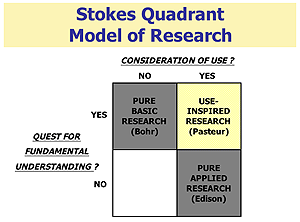|
|
At the other extreme is pure applied research, and the classic example I give is that of Thomas Edison. Now, I lived in Michigan for more than 16 years, and we used to always go to the Henry Ford Museum in Greenfield Village. So there you go into Edison's lab, and one of the first things to strike you is that it looks more like a kitchen than a lab. His approach: Don't worry about a quest for fundamental understanding; let's just keep trying something until we get the right material that gives us the light and the conversion efficiency that we need and the lifetime that we need. There's really no questioning, and if you look at his notes, they're the same way. They’re more like a checklist. Like I said, it's more like a recipe than a scientific prescription. “Just try this.” “Did we try it?” “Yes.” “Did it work?” “No.” “All right, try this.” “Did it work?” And so on—systematized, all right, but no question for fundamental understanding.
Pasteur sits in another quadrant. Was there a consideration of use? Damn straight, there was, with the milk and the wine and all this. The government came to him with questions, and then he got real inspired about what's going on, went backward, and what did it lead to? Was there a quest for understanding? Yes, because he came into it with an attitude of wanting to know the cause, and from that came up with the pathogen theory of disease—again, one of the most fundamental things from the 19th century, which led into some of the biological revolutions in genetics in the early 20th century, which led to the molecular revolution of the end of the last century and this century. [Pasteur’s research] had both of these characteristics: consideration of use and a fundamental quest. This is use-inspired research.
Use-inspired research is the driving force of research by professionals—research by people who interact with the real world, deal with it daily, create for that world, and produce product. The second piece of research is the process. That's the concept, this idea, of the quest for knowledge but done in this way that’s inspired by use. The process, when use-inspired, becomes dynamic instead of static. That one-dimensional world is static; you cannot launch into the applied-research stage until the fundamental stage is ended. You cannot launch into the technological development stage until the applied-research stage has ended. It's a very static view.
>
01 02 03 04 05 06 07 08 09 10 11 12 13 14 15 16 17 18 19 |
|

|
